
FALL 2022 | VOLUME 101 NUMBER 1 DOGS IN SCHOOLS BRING STRESS RELIEF & FUN GOING GRADELESS IN STEM COURSES RESILIENCE PROJECT BRINGS DIVERSE PERSPECTIVES A NEW ERA IN TEACHER COLLECTIVE BARGAINING
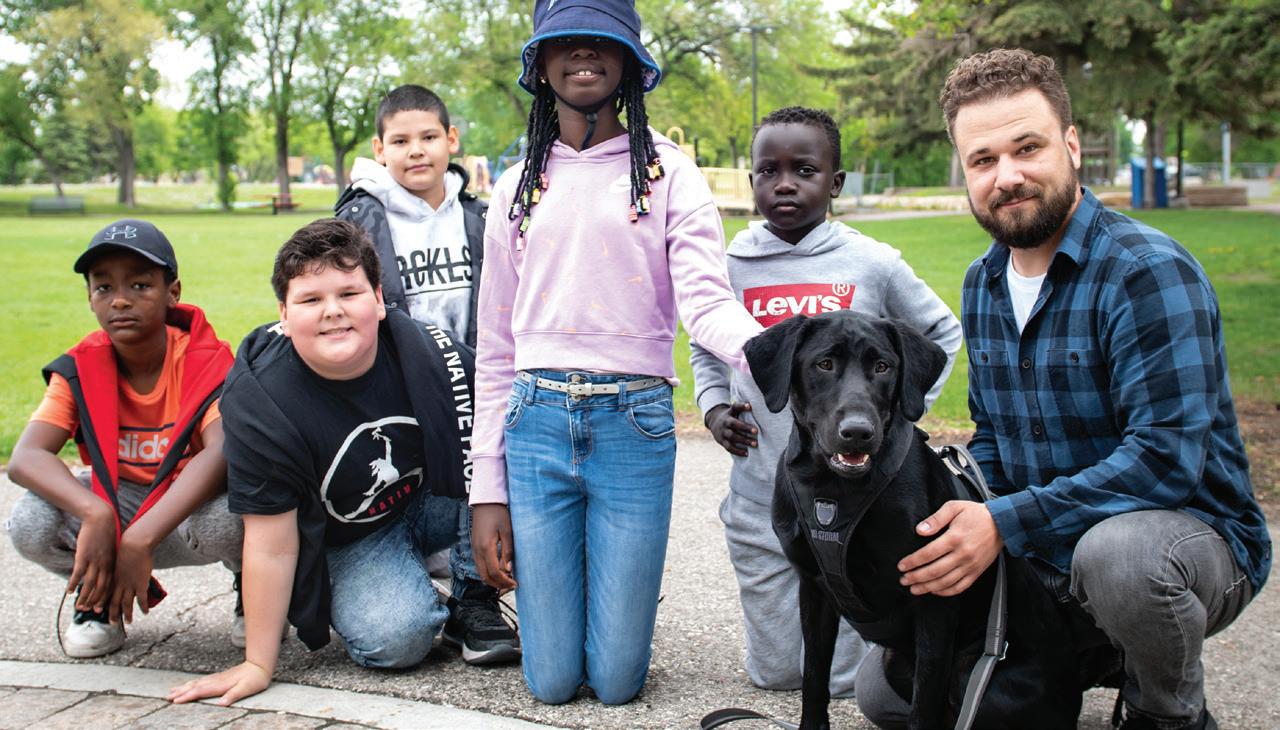
CONTENTS FALL 2022 | VOLUME 101 NUMBER 1 Meet Berkley, a facility dog trained to provide support at Brooklands School. Long-time dog lover Andrew Sullivan, a teacher at Brooklands and Berkley’s owner, says having a dog specially trained to reduce stress pays big dividends, from calming and grounding anxious students to encouraging participation in learning activities like reading. 14 COVER STORY BACK TO SCHOOL IS PAWSITIVELY EXCITING FOR FACILITY DOG BERKLEY FROM THE PRESIDENT5 FROM THE EXECUTIVE DIRECTOR7 COLLABORATIVE LEARNING TEAMS SCHOOL TRUSTEES 20 22 TIME TO TALK MTS PD TRAINING FOR THE (MENTAL) MARATHON THE PRINCIPAL OF THE THING 26 30 32 14
The Resilience project is based on a national billboard art exhibition that featured the works of 50 Indigenous women artists. Made up of 50 Indigenous art cards complete with a teaching guide, the Resilience project is full of ideas on how to use the art cards to animate discussions and inspire activities in all subjects, from kindergarten to Grade 12.

For Brandon teacher Christopher Sarkonak, the question was clear: Which is more important, that students memorize a process or some random information and regurgitate it on a test, or that they develop the skills to think critically and problem solve? His answer: move to a skills-based grading model. And then, he went gradeless.

After more than a century of bargaining hundreds of collective agreements for individual Locals across Manitoba, the province’s teachers will, for the first time, come to the table in their entirety to negotiate two agreements for the more than 16,000 members of MTS. How did we get here? And what can we expect?

12 8 16 THE RESILIENCE PROJECT: BRINGS DIVERSE PERSPECTIVES TO ART EDUCATION GOING GRADELESS: FROM PANDEMIC TEACHING TO STUDENT EMPOWERMENT ALL FOR ONE AND ONE FOR ALL: A NEW ERA IN COLLECTIVE BARGAINING 12 8 16 BOOK REVIEWS PG.34
CONTRIBUTORS
EDITOR
Anne Bennett abennett@mbteach.org

ART DIRECTION AND DESIGN
Krista Rutledge krutledge@mbteach.org
PHOTOGRAPHY
Matea Tuhtar mtuhtar@mbteach.org
CIRCULATION
Jennifer Nasse jnasse@mbteach.org

ADVERTISING
Matea Tuhtar advertising@mbteach.org
SUBSCRIPTIONS
The MB Teacher is published three times a year by The Manitoba Teachers’ Society. Articles and views published herein do not necessarily represent the policies nor the views of the Society. ©2022 by The Manitoba Teachers’ Society. Unauthorized use or duplication without prior approval is strictly prohibited.
THE MANITOBA TEACHERS’ SOCIETY
191 Harcourt Street
Winnipeg, Manitoba R3J 3H2
Phone: 204-888-7961 Fax : 204-831-0877
PUBLICATIONS MAIL AGREEMENT
40063378 ISSN 002-228X
Return undeliverable Canadian addresses to Contact Services at The Manitoba Teachers’ Society.
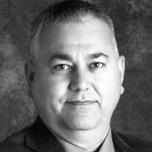
Christopher Sarkonak
PAGE 8
Christopher Sarkonak is a Grades 9-12 physics and mathematics teacher at Crocus Plains Regional Secondary School in Brandon. He’s the regional coordinator in Manitoba for the Perimeter Institute Teacher Network and a passionate advocate for STEM. Sarkonak is the teacher supervisor for his school’s STEM Club, featuring a STEM for Girls week and a student outreach program aimed at K-8 students across the province.
Irene Nordheim
PAGE 30
Irene Nordheim recently retired after 43 years in the education field. She has served as assistant superintendent for Louis Riel School Division, where her portfolio included the supervision of 14 schools, curriculum and programming, fine arts education, practical arts education, physical education and libraries. Prior to that, Irene was the principal at Glenlawn Collegiate, Windsor Park Collegiate and vice principal at JH Bruns, Samuel Burland, and St. George Schools.
Ryan Desjarlais
PAGE 28
Ryan Desjarlais was a college instructor for ten years and has been a high school sciences teacher for the past twenty. He currently teaches physics at Winnipeg’s Stevenson Britannia Adult Learning Centre and is passionate about integrating academic sciences with vocational programming.

Dr. Alysha Farrell Ph.D.
PAGE 32
Dr. Alysha Farrell is an associate professor and the chair of the Leadership and Educational Administration Department in the Faculty of Education at Brandon University. An educator in Manitoba for over 20 years, her research focuses on relationship building and the emotional dimensions of teaching, leading, and learning in the face of climate change.
/manitobateachers /mbteachers
FALL 2022 www.mbteach.org
After being grounded for almost three years, many of us have begun to travel once again by plane. A number of things have changed in the realm of air travel since COVID-19 gripped the planet, but one thing remains the same: We are reminded that in an emergency, we must first put on our own oxygen mask before helping another with theirs.
It was 20 years ago in the first column I wrote as president of the St. Boniface Teachers’ Association that I first used the oxygen mask analogy. I asked that members prioritize their health, both physical and mental. A teacher who is ill or languishing cannot look after others effectively.
The message still applies. The difference between now and then, however, is that your Society has evolved significantly in its ability to assist you in putting on—and relying on—that oxygen mask.
STAYING HEALTHY AND ENGAGED
For example, MTS has contracted with HumanaCare to provide counseling services to all members and their families. Information is available on our website, mbteach.org. Use this service. It is there to support you.
The Province of Manitoba has also provided funding to create Care For All In Education , an online platform created by the Canadian Mental Health Association and supported by MTS, offering a range of services uniquely tailored to the needs of all who work in education. Again, the resource is there to help you stay healthy mentally—for you, for those you teach, and for those you love. You’ll find an article about the service in this issue.

WORK IS WELL UNDERWAY
We know that many of the classroom challenges that existed prior to the pandemic still exist: large class sizes, shortages of substitutes and clinicians, lack of funding for classroom supports, and so on. The pandemic has heightened the public’s awareness of the impacts of poverty on our classrooms and provincial funding is not keeping pace with the rate of inflation. Nothing is getting easier. Rest assured that your union will bring these issues to the provincial bargaining table this fall and look for lasting solutions there. But in the meantime, you need to look after yourself.
Please be there for each other. Draw upon the resources of your Society, including the ample professional development opportunities outlined in this magazine to support, sustain and inspire you in 2022-23.
THE GOAL IS CLEAR
At the Society, we shall continue to advocate for the resources you need to be successful with your students. Always remember that your MTS staff are no more than a phone call or email away.
This will be a historic year, as your bargaining committee negotiates the first ever single-tier collective agreement for all MTS members. Work is well underway, and the goal is clear: obtain the best possible agreement with the best language and provisions possible for each and every member across the province.
Big things are happening, so your own oxygen mask must come first. Stay healthy, stay informed, and stay engaged.
I wish you a wonderfully successful school year.
FALL 2022 | THE MB TEACHER 5
James Bedford
At the Society, we shall continue to advocate for the resources you need to be successful with your students.
FROM
THE PRESIDENT
Keep updated with the SUB

The Manitoba Sub is a monthly e-newsletter with breaking news, upcoming events and much more delivered right to your inbox. Didn’t get the email? Call Contact Services to update your email address. Still didn’t get the email? Check your spam folder! This is an email worth reading. Contact Services can be reached at: 1-800-262-8803
While I no longer teach in a classroom, I’m still feeling all the feels of a new school year: the reset, renew, recharged sentiments of possibility and opportunity. Getting organized is fueled by pumpkin spice lattes and the faint aroma of evening fires that make brisk nights more tolerable. Yes, things are cooling down, but at MTS, they’re also heating up.
Our operational work is anchored by emerging issues in education, the programs and services of our internal departments (Teacher Welfare, Professional and French Language Services, Disability Benefits, and Communications and Contact Services) as well as the operationalization of action resolutions passed at Provincial Council 2022. The 2STLGBQIA+ Ad Hoc Committee and 18 other MTS committees articulated a further 91 recommendations that have been reviewed and prioritized. Our work is cut out for us with exciting projects, advocacy, and committees.
With the death of Bill 64, and based on feedback from education partners like MTS, the government’s education priorities have been repositioned and renamed in its Action Plan. Indeed, there are currently 33 MTS representatives on Manitoba Education and Early Childhood Learning committees, along with extensive staff and member participation on 55 outside committees, advisory groups, and task forces (compared to 24 in September 2020). This vast engagement supports the political work of the Provincial Executive in setting and articulating the union’s strategic direction.
Provincial bargaining will be a significant priority and time commitment, operationally and politically. The importance of these inaugural central table negotiations cannot be overstated,
FEELING THE FEELS OF SEPTEMBER
Danielle Fullan Kolton, Ph.D.

Yes, things are cooling down, but at MTS, they’re also heating up.
and MTS is eager to bargain the first collective agreement covering all members. Read more about this in All for One and One for All – A New Era in Collective Bargaining
We are also closely following the development of leadership standards, teacher regulation initiatives (Teachers’ College), and support for French education. These areas of focus are critical to one of our key missions to advance and safeguard the status of the profession. Check out Time to Talk MTS PD for all things professional development through MTS. You’ll also find the first regular feature profiling our Special Area Groups of Educators (SAGEs). These reads are a great primer for MTS PD Day, October 20, 2022.
As your union, we are committed to raising the profile of labour concerns, justice/equity goals, professional status, and public education policies and issues. We must all pay attention, stay informed, talk to others, and act. Collectively, and for the common good, we cannot afford to be silent. MTS will continue to raise your voices.
This is the first issue of the MB Teacher magazine to be offered electronically to all members, in accordance with a resolution passed at Provincial Council 2022. If you wish to receive the magazine in print, please elect to do so by logging into your MyProfile account and selecting the print option.
The year ahead will not be for the faint of heart. Peppered with opportunities to showcase our continued leadership, commitment, and service to our members, we look forward to ongoing work and collaboration.
Ready? Set. Go! Together, we’ve got this.
FALL 2022 | THE MB TEACHER 7
FROM THE EXECUTIVE DIRECTOR
GOING GRADELESS IN STEM: FROM PANDEMIC TEACHING TO STUDENT EMPOWERMENT
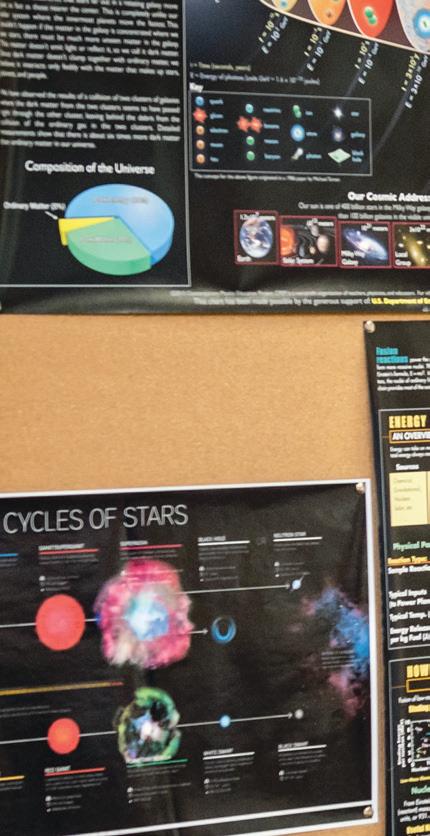 By Christopher Sarkonak, Brandon Teachers’ Association
By Christopher Sarkonak, Brandon Teachers’ Association
Like most teachers, the pandemic made me reconsider a lot of what I do. Remote learning had me questioning the effectiveness of simply adapting the tools I’d always used in the classroom. The process put me on a path that revolutionized my practice.
The idea that the grade no longer limited a student and that they could improve to a high grade that was representative of what they were actually capable of by the end of the course was profoundly impactful. It was a transformative change for both the students and me, as we all finally felt like we were focused on the right thing.
When we flipped to remote learning, I asked myself, “How do I make sure students are actually continuing to learn? Am I just having them jump through hoops while I knowingly turn a blind eye to cheating?” Putting my assignments and tests online didn’t guarantee that learning would happen. I wrestled with these questions every day.
My solution to remote learning in March, 2020 was a system where students
accumulated points through completing online simulations, at-home experiments, and a major project that ranged from building a project that demonstrated a concept, to developing their own lab, to creating a context-rich problem. All were tasks that required students to display their level of understanding as there was no memorizing or cheating their way through.
TREMENDOUS INSIGHTS INTO LEARNING
During one-on-one interviews with students, I gained tremendous insights into their learning. One student had 95 per cent in my class until we went remote. But when he decided to develop a project,
it became clear that he had little to no understanding of basic physics. When we talked, it was revealed that he memorized what he needed to get good grades on tests, but retained almost nothing. Another student with a 55 per cent in the course created the most engaging and well-thought-out context-rich problems that incorporated his own love of graphic design. During our interviews he showed genuine interest in physics and that he could, and should, go much farther. However, his grade communicated to him that he could never be successful.
This drove significant change in my vision for the classroom for fall, 2020. My question was: which is more important, that students can memorize a process or some random information and
8 THE MB TEACHER | FALL 2022
regurgitate it for me on a test, or that they develop the skills to think critically and problem solve?
We often think of students who do well on tests as the ones set up to succeed after high school, but it’s those students who are often least prepared for the deeper thinking required of university, college, or a 21st century workforce. As teachers, we may inadvertently act as gatekeepers that prevent a wonderfully creative, insightful student from realizing their potential –beaten down by a system that punishes every little mistake and stifles creativity, especially in STEM courses.
My solution: move to a skills-based grading model. Check out Scott Brunner’s blog, Physicstory.com or scan the QR code (on page 10) for more info.
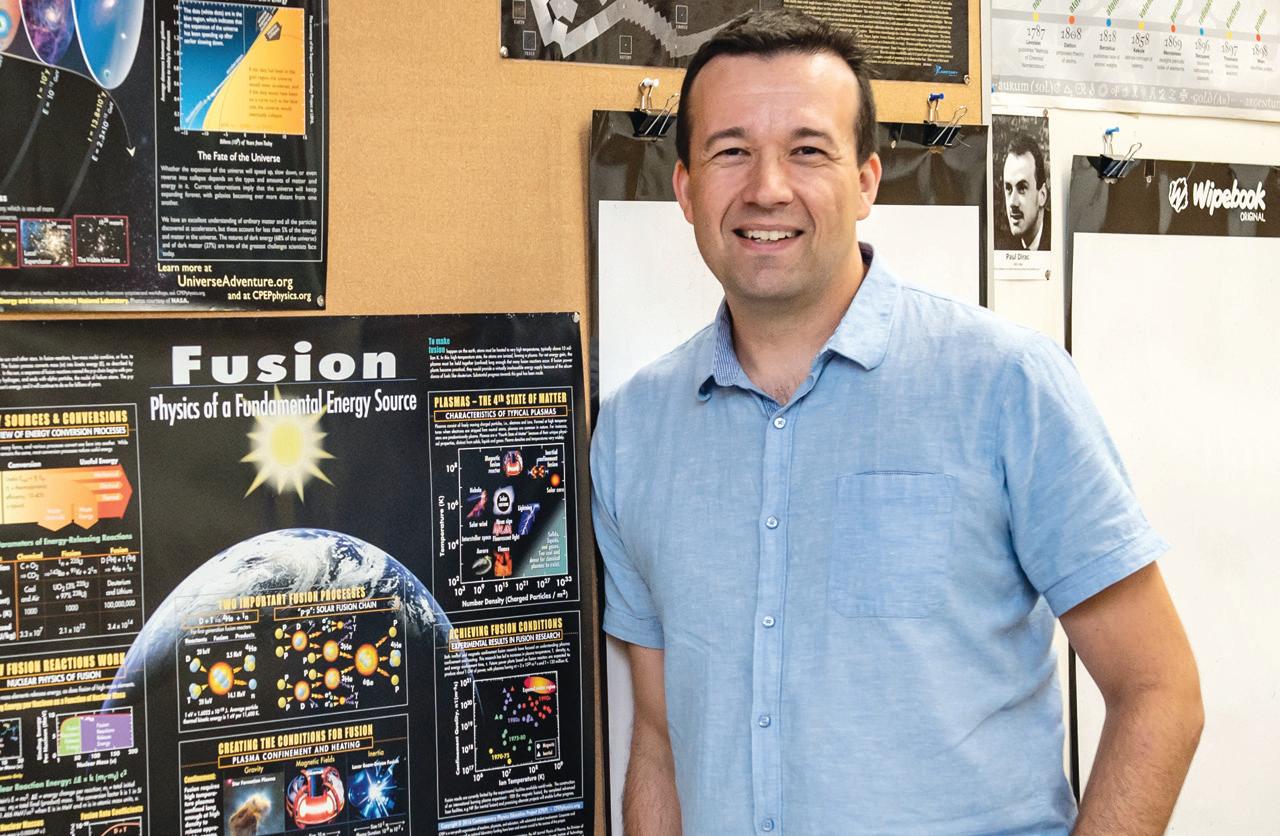
SKILLS-BASED GRADING MODEL
The idea was that, with student input, we select key skills from the Cluster 0 section of the Manitoba Science Curriculum that would help students be successful, not only in this course, but also in university, college, the workforce, and their personal lives. These skills were present in every topic in the course, so if we were assessing skills, then students’ grades could actually grow as they do. One of the biggest problems with traditional grading is that it doesn’t reflect student growth and this undermines student engagement and resilience. In a traditional events-based grading system, all tasks, new and old,
are part of the grade and there are often limited, or no opportunities for students to demonstrate growth.
The idea that the grade no longer limited a student and that they could improve to a high grade that was representative of what they were actually capable of by the end of the course was profoundly impactful. It was a transformative change for both the students and me, as we all finally felt like we were focused on the right thing.
Then, I made another big shift. During the winter, 2021 semester, I explored the idea of going gradeless, or ungrading. Ungrading means acknowledging that grades can prevent students from taking risks in their learning, push them to cheat or give up entirely and act out, and
FALL 2022 | THE MB TEACHER 9
sometimes result in anxiety or depression, and so we work to remove the grade as much as possible from a course.
I had already seen how grades held students back from what they could be and how traditional grading was focused on getting students ready for the test or final exam, but not on the learning itself. I read an article by Ontario physics teacher, Ashley McCarl Palmer, titled “So you want to go gradeless” , and we soon started working together. This collaboration was a tremendous push in the right direction.
SKILLS-BASED UNGRADING
In fall, 2021, I moved to what I call “skills-based ungrading”. We select the skills that students need to develop to be successful long-term, and each semester we revisit them and provide opportunity for new input. We have no choice but to determine grades at midterm and finals, so this has become part of a self-assessment process. In a one-on-one interview with me they justify the grade they have selected, supported by their portfolio of work— similar to a job interview.
In this assessment model, all coursework is formative until the student decides what is summative in their portfolio. It gives students the opportunity to showcase their growth and puts as much ownership as possible on them. Since we want our grades to be more meaningful, as a class we developed our “What Does a Grade Look Like?” sheet so that students know what each grade range looks like, along with the criteria for requesting each level of grade. The criteria that students evaluate on this sheet are based on the problem-solving and critical thinking skills that we should value most, not the content.
And what are the results, you ask? Far beyond my wildest dreams!
STUDENTS TAKE OWNERSHIP OF THEIR LEARNING
My students know that this course is about their growth and long-term success, so they take ownership of their
learning. They’re more engaged than I’ve ever seen a class. Since students know that they will grow throughout the course and won’t be punished for mistakes in the long term, there is much more risktaking, incredible collaboration between students, and no more cheating.
One of the most important benefits is that student anxiety is almost nonexistent. Many students who previously suffered from debilitating anxiety no longer feel it in this course. And they’re even able to transfer skills to other more traditional courses. I’m able to ask my students more challenging questions than I ever have before and I see far greater success from them. Students
that have traditionally struggled with a course like physics are engaging with the course, building confidence, rising to the challenge and finding success.
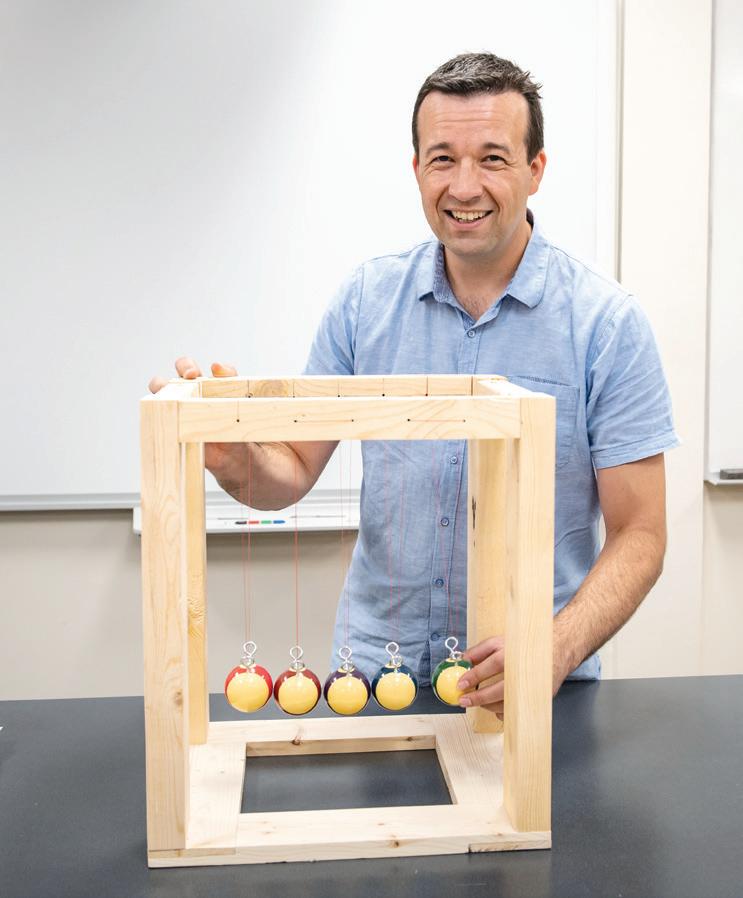
On my side, regular feedback and asking questions that dig deeper into their understanding means that I’m taking less work home with me. I have the healthiest work-life balance of my career and teaching itself feels far more fulfilling—the way it always should have been.
COVID-19 robbed our classrooms of so much. Who would have thought it could also create so much opportunity?
10 THE MB TEACHER | FALL 2022
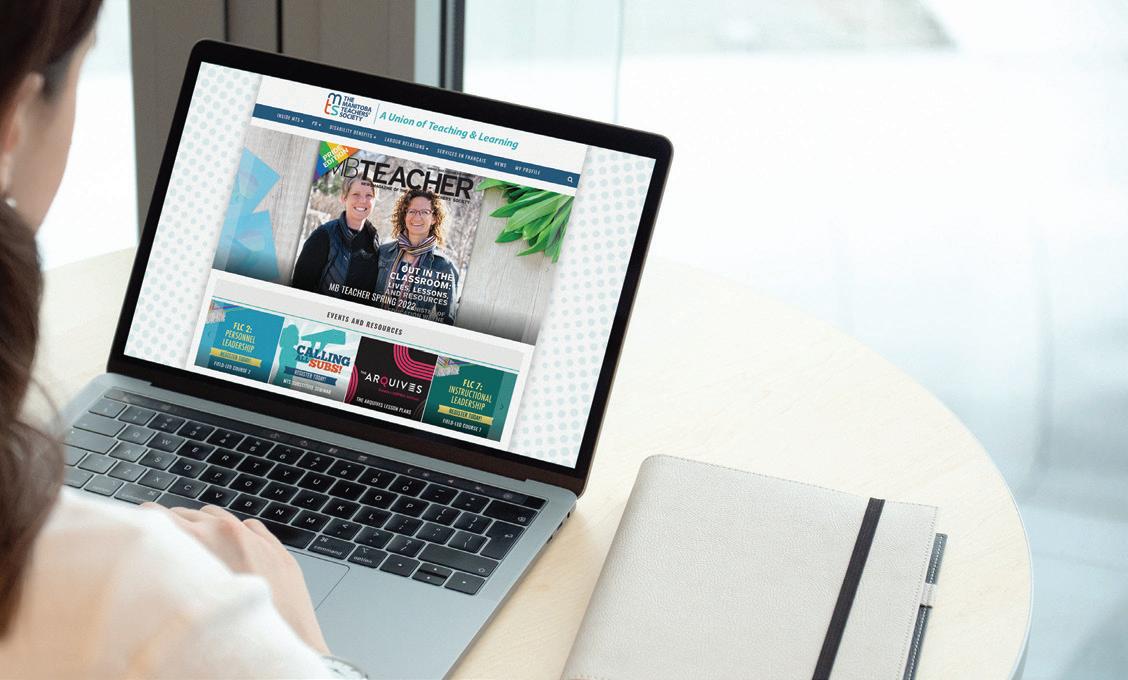

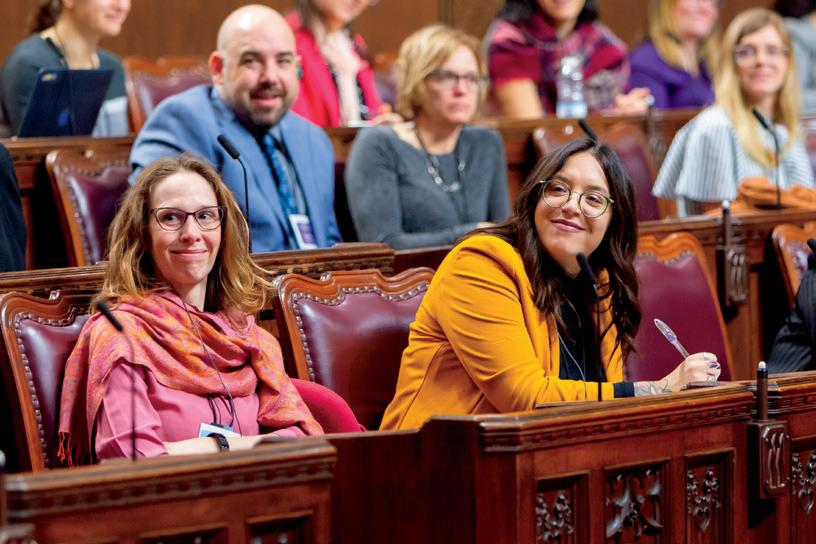
FALL 2022 | THE MB TEACHER 11 Get access to exclusive content : • More PD events for you • The freshest news on bargaining • Workload surveys • SAGE developments • The Sub email blast MTS MEMBERS CREATE YOUR MY PROFILE ACCOUNT l e a r n . p a r l . c a / t e a c h e r s T e a c h e r s I n s t i t u t e o n C a n a d i a n P a r l i a m e n t a r y D e m o c r a c y Participate in a week-long intensive training opportunity for educators at Parliament A p p l y b y O c t . 1 0 , 2 0 2 2
RESILIENCE PROJECT BRINGS DIVERSE PERSPECTIVE TO ART EDUCATION
By Matea Tuhtar, MTS Staff
Eurocentrism has long played a role in art teaching, but some educators are looking to change the status quo. “What we’re trying to do in art education is really move to full integration and inclusivity, so that we’re looking at works from all sorts of people,” says Dawn Knight, an artist and art teacher at Fort Richmond Collegiate.
Enter the Resilience project. Based on a national billboard art exhibition that featured the works of 50 Indigenous women artists, the Resilience project is made up of 50 Indigenous art cards complete with a teaching guide. It contains 50 full-colour, 8"x10" reproductions of contemporary Indigenous art and a bilingual (English/ French) teaching guide, full of ideas on how to use the art cards to animate discussions and inspire activities in all subjects, from kindergarten to grade 12.
The one piece that stands out to Dawn Knight, an artist and art teacher at Fort Richmond Collegiate, is by Christi Belcourt entitled This Painting is a Mirror . Belcourt uses paint on canvas to portray traditional beadwork esthetics.

The original show was produced by MAWA (Mentoring Artists for Women’s Art), an organization that Knight is a part of. “I was at a PD session at Art Junktion in 2018 with Shawna Dempsey, one of the co-directors at MAWA,” says Knight. “And we were looking at a lot of art images from books and one of the things we were noticing was that a lot of the access to images in art classrooms is really limited to dead, white, European men.”
AMAZING RESOURCE FOR EDUCATORS
Knight and Dempsey realized that the Resilience billboard project that was happening at the time would be an amazing resource for classrooms and educators. “Shawna is very supportive of educators and she did a lot of work to raise funding so that we could put together a teachers box set of images from the exhibition.”
Each of the prints feature full colour images with a piece of writing on the back. In some cases it’s poetry, or the artist’s
statement or an idea about the work. The artwork was created by First Nations, Inuit and Métis women artists and is a physicalized reminder of buried histories and diverse contemporary perspectives. As the teaching guide states: By using these art cards, you are doing important and essential work. You are responding to Call to Action #62 of the Truth and Reconciliation Commission of Canada….and validating the experiences and traditions of your Indigenous students, and instilling respect and understanding for Indigenous Peoples in students of all backgrounds.
Knight was one of the four writers who wrote the teaching guide because of her background in art history. “The guide covers a lot of topics, it’s not necessarily just for art teachers, but also K-12 teachers in different subject areas such as math, science, English and Social Studies,” she explains. “A lot of lessons can come out of this artwork including environmental stewardship, land rights, water rights and missing and murdered Indigenous women.”
The pieces are made up of various media including performative works, crafts, photography, installation work and illustrations, and the lesson plans are thematic and topic based. For Knight they’ve inspired a recent artwork project with her students entitled the HIStory/HERstory/ THEIRstory project, where each student selfreflected on their own resilience story and what factors in their life have influenced their identity.
“We looked at all aspects of identity and asked some big questions. Resilience looks different for every student, some students are from a family that immigrated here, others are dealing with personal issues or mental health, or different things around family structure and family dynamics.”
Knight says it’s important that no cultural appropriation is happening. “I don’t want my
12 THE MB TEACHER | FALL 2022
students to copy an artist, the idea is to look at the ‘thinking’ that the artist has done. I want them to look at the aesthetic choices the artist has made, but also contextual choices.”
“We ask questions about the ideas behind the art so that it becomes about thinking about the art piece and realizing that all of us bring our own baggage to an art piece. And so the meaning of the artwork isn’t just made by the artist, but actually by the audience as well.”
ARTISTS’ VOICES BROUGHT INTO CLASSROOM
The students’ reactions to the cards have been very positive. “There’s a lot of great discussions that come out of it. And I’m finding that there’s a lot of art pieces that kids might not select as an interesting piece, but when we spend time with them, suddenly
they mean much more to them.” Knight says another value of the cards is that it’s the artists who are speaking about their own work. “I don’t want to be the voice of these women, they have their own experiences and I value that, and I think it’s super important that these voices are brought into our rooms.”
For Knight, one of the pieces that stand out most to her is by Christi Belcourt entitled This Painting is a Mirror. Belcourt uses paint on canvas to portray traditional beadwork esthetics. “She speaks so much about our interconnectedness with land and how we’re linked—the air that I’m breathing right now and the water I drink is the water that my ancestors also drank.”

MAWA has been able to raise enough funding to provide every school in Winnipeg with a box set of the cards. The Manitoba Association of Art Educators has also been providing the image package to teachers
who want them. All band schools in Manitoba have also received copies.
“They’ve truly been an amazing resource,” says Knight. “We had a great PD session in 2021 where we got Alisha Mernick from the US to do a session called ‘Decentering Whiteness in the Classroom’. So much of what she spoke about resonated for me and is really the direction I’m hoping our classrooms move into, which is presenting multiple voices and not just the stuff that is in 99% of art books. By looking at pieces like the art cards—they’re so much more than an artwork, they hold entire histories in them. And when we’re presented with different voices we’re all better for it. All of our students are better for it.”
Scan the QR code or click here to learn more about the Resilience project and access free PDFs of the art cards and the teaching guide.
FALL 2022 | THE MB TEACHER 13
ARTWORK BY JACKIE TRAVERSE / HARVESTING THE HAIR OF MOTHER EARTH –2019
DOGS IN SCHOOLS BRING STRESS RELIEF & FUN
By Matea Tuhtar, MTS Staff
Back to school might not be fun for everyone but it’s a pawsitively exciting time when you’re a black lab named Berkley.
Heading back to Brooklands School for his second year, Berkley can’t wait to join his classmates for another school year.
“He just loves coming to school,” says Andrew Sullivan, a teacher at Brooklands who’s also Berkley’s full-time owner and trainer. “He gets so excited to put on his vest and get to work. Everyone loves him, he’s the most popular teacher here!”
A longtime dog lover, Sullivan began doing research about dogs in schools around the time he brought Berkley home as a pup. “I was always the weird guy who took my dog everywhere with me. I knew about how much dogs have benefited me in my life, and I kind of went down the rabbit hole of learning more about therapy dogs and canine assisted learning and the benefits of having a dog around.”
His research led him to an organization called MSAR that trains and certifies service dogs in Manitoba. He approached his then principal Rex Ferguson who was on board and wrote a proposal to the division which also gave the green light. MSAR volunteered their services and provided all of Berkley’s necessary training.
THERAPY DOG TRAINED TO SUIT NEEDS OF FACILITY
Berkley is a facility dog, which is a type of therapy dog that’s trained to provide certain services and behaviors that suit the needs of the facility. In Berkley’s case, a school. When used in the educational system, facility dogs can calm students and reduce stress during the learning process. They can also motivate students to participate in learning activities and are helpful for the improvement of speech skills through
activities like reading to the dog or talking about the dog.
“Because he’s my dog, I’m doing all the training with him,” says Sullivan. “He’s like my co-teacher. He’s with me all day but he works with all the students in the school.”
Berkley’s training has included a lot of socializing with humans and other dogs, as well as lots of public access training, in addition to basic puppy obedience and manners. He’s also had a lot of exposure to things like wheelchairs, lawnmowers, cars, airplanes and other loud noises.
“The most important thing has been to get him used to a lot of people and building up his confidence,” says Sullivan, who picked Berkley specifically because he was the most confident and eager to please pup in the litter. “You need a happy and confident dog to be successful in the school, so he can’t be easily startled. Kids can be unpredictable, and sometimes we’ll have students who will scream or cry, so he has to be able to handle that.”
Labs are a popular breed for service dogs due to their temperament and size. “He’s not small and delicate so he can handle kids, but he’s not so big that it’s difficult to get around with him. So the idea is that when we’re in the classroom and teaching is going on, you want him there, but it’s better if he’s unnoticed. And then when it’s time to read or do activities he can go around and do stuff. When he’s needed, he’s on.”
“When there’s a kid who’s having a hard time I ask them to come for a walk with Berkley and I. We do a loop and then come back to class and it’s like a reset for them. It’s pretty amazing.”
Having a dog in the school has been
a learning curve for some students and community members who might not have had a lot of dog experience in the past. Sullivan says slow introductions are key. “One little girl in particular was terrified every time she saw Berkley in the hallway. And today she’s his biggest fan. She calls his name and comes up to see him. It’s a remarkable change.”
BERKLEY CALMS AND GROUNDS STUDENTS
Education is key when having a dog in school and Sullivan lets everyone know that Berkley is there to do a job, that he is in training and has a purpose. He’s also careful to let kids know that not every dog they meet will be like Berkley.
“That’s part of what I do when I go around classrooms with him. I tell kids
‘This is Berkley, he’s here for you and you can pet him, but you have to be cautious around dogs you don’t know. We can’t go up to every dog and pet them if we don’t know them. It’s important to talk to the owner first.’”
Sullivan says he would 100 per cent recommend having a dog in school. “It’s pretty remarkable how a dog can allow a child to let their guard down. Some kids come to school upset or elevated and then they get down on his level, spend some time with him and just get grounded. He doesn’t judge, just offers unconditional love. Which is something we all need.”
For questions about having a facility dog in school, contact Sullivan at andrew.sullivan@ sjasd.ca. Scan the QR code for more on MSAR
14 THE MB TEACHER | FALL 2022

FALL 2022 | THE MB TEACHER 15
ALL FOR ONE AND ONE FOR ALL A NEW ERA IN COLLECTIVE BARGAINING
By Anne Bennett, MTS Staff
This fall MTS undertakes the first round of central table collective bargaining in the history of our union. The significance is impossible to overstate.
After more than a century of bargaining hundreds of collective agreements for individual Locals across Manitoba, the province’s teachers will, for the first time, come to the table in their entirety to negotiate two agreements for the more than 16,000 members of MTS. One agreement covers 37 school divisions across the province, with a separate agreement for L'Association des éducatrices et éducateurs franco-manitobains (AÉFM).
While the lead table strategy employed by MTS for decades—one where the agreement reached first among Manitoba Locals sets the standard for remaining Local agreements— has proven effective, it has not always been equitable. MTS has long argued that some teachers, particularly those in smaller and less populous areas, have not enjoyed the same benefits and language obtained by colleagues elsewhere in the province.
“And that is why this moment is so important,” says James Bedford, MTS president. “There is strength in numbers and there is strength in having equity across the province. Our table team’s success will be defined by a province-wide agreement that reflects the needs of all members and enshrines the hard-fought salary, rights, working conditions and language that has evolved in Manitoba for over a century.”
A BIT OF HISTORY
At MTS Provincial Council 2001, Resolution BA12 was passed by the assembly. The resolution called for a study and report on the impact of a single-tier (one table
for English and French) bargaining model, triggering a process that included a brief to the Minister of Education advocating for a single collective agreement negotiated at a single table, setting teacher salaries, benefits and working conditions at the highest level across the province.
In 2011, MTS again lobbied the government for change via the union’s Provincial Bargaining Model Review Committee report, submitted to Provincial Council. The document put forward recommendations that would establish principles of bargaining within the context of a single tier or a twotier (two tables: one French and one English) bargaining model.
Finally, in February, 2018, the provincial government announced its intention to move to provincial bargaining. At MTS Provincial Council AGM that year, Resolution BA1 was passed. It stated that “the Collective Bargaining Standing Committee be tasked with defining all operational details of the Provincial Bargaining Model (2011) for recommendations to the 2019 Provincial Council.”
Government officials began meeting with MTS in early 2018, with subsequent meetings taking place through January of the following year. In the spring of 2019, the province announced its intention to introduce legislation to replace the current system of Local bargaining with a provincial model.
Since that time MTS has delved deeply into preparations for negotiations, setting the stage with consecutive arbitration
awards (Louis Riel and Pembina Trails Teachers’ Associations) that netted salary increases for teachers and laid the foundation for negotiation of the first-ever single-tier contract.
The Society is eager to begin this seminal round of bargaining.
“It’s the culmination of years of work to develop processes, protocols, and ultimately an opening package,” Bedford says. “Bargaining is fulfilling work. It has an immediate impact on the welfare of teachers, not only in terms of pay but also rights, working conditions, benefits and leaves. This is what we do, and we’re dedicated to it.”
LEGISLATIVE LIMBO
The path to progress has certainly seen its fair share of drama.
In 2017, the Manitoba government introduced Bill 28: The Public Sector Sustainability Act, casting a pall over public sector collective bargaining throughout the province. After a lengthy legal challenge in which MTS energetically participated, the legislation was ceremoniously struck down in the Court of Queen’s Bench as unconstitutional in June, 2020.
In 2019, the government put Bill 26: The Public Schools Amendment Act, on the Order Paper. However, the legislation, intended to usher in centralized teacher bargaining was never introduced.
On March 15, 2021, the report of the Commission on K-12 Education was
16 THE MB TEACHER | FALL 2022
unveiled along with Bill 64: The Education Modernization Act: a thinly veiled attempt to decimate school divisions, wrest control over local education from elected school trustees, remove principals and vice principals from the teacher bargaining unit in favour of “managers”, and politicize school curricula.
MTS mounted a relentless campaign against the legislation, along with education partners, faculties of education and opposition parties. The resulting public outcry forced the government to withdraw the legislation in 2021—along with a variety of other Bills—and compelled the premier to resign.
One key piece of legislation that survived the tumultuous legislative session was Bill 45: The Public Schools Amendment and The Manitoba Teachers’ Society Amendment Act. This, at long last, created the structure for provincial bargaining.
MTS’ POSITIONS ON PROVINCIAL BARGAINING
MTS supports single-tier provincial bargaining with a uniform collective agreement for all teachers, subject to conditions. These include that:
• teachers will continue to be governed by the Labour Relations Act,
• MTS will bargain on behalf of teachers directly with the Province of Manitoba (the funder),
• bargaining must be free, fair and with an open scope,
• mechanisms for dispute resolution, such as interest arbitration, must be without limitation,
• the best provisions from existing collective agreements be the standard for the new contract,
• membership in MTS shall remain as it currently exists.
THE DOMINO EFFECT
MTS is prepared to begin once dates for negotiations are set (the Society sent letters to the minister of education for the anglophone table and the DSFM board chair for the francophone table per Bill 45 in April, 2022). Dates have been set for the Anglophone table, while AÉFM awaits confirmation from the Division scolaire franco-manitobaine (DSFM).
“I hope our members engage in the process, follow the updates, and remember that bargaining is about bettering the lives of the collective,” says Bedford. “Solidarity is the key to the strength that 16,000 members provide. Our success will be defined by a negotiation that is fair, respectful and in the spirit of creating better public education for our students through improved remuneration and working conditions for our teachers.”
“Bargaining on behalf of members is a trust and a privilege. We want the best deal possible, and we’ll get there together.”
In the summer of 2020, with Bill 28 defeated, MTS and Local bargainers took direct aim at wage restraint. Victories in both the Louis Riel and Pembina Trails arbitrations netted members significant wage gains and collective agreement language improvements, setting the stage for negotiations on behalf of all other Manitoba Locals. But the clock was ticking: all agreements had to be settled prior to passage of Bill 45. And they fell like dominos. On May 20, 2021, the last of the 38 Locals settled*, ensuring that all Manitoba teachers received salary increases for 2018-2022—a momentous achievement. The union had overcome a perilous labour landscape to succeed in the courts, at the arbitration table and, ultimately, the bargaining table.
*4-year agreements of 1.6%, 1.4%, 0.5%, and COLA, expiring June 30, 2022
SINGLE-TIER BARGAINING
Resolution calling for study of single-tier bargaining model passed at MTS Provincial Council
bargaining continues
presents Provincial Bargaining Model Review Report to government
28 introduced. Labour community, including MTS, launches legal challenge
continues single-tier lobbying with
Local bargaining continues
announces
to replace
bargaining with provincial model
announces Bill 26, intended
centralize teacher bargaining, but does
introduce
strikes down Bill 28: declared
45 introduced: opens pathway to provincial bargaining
Government introduces Bill 64: faces sweeping opposition
Government forced to withdraw Bill 64, Provincial Bargaining protocol implemented, final round of Local bargaining completed, with four-year deals achieved for all
2022
Bill 45 proclaimed: enshrines structure for single-tier bargaining in MB
FALL 2022 | THE MB TEACHER 17
2001
2001-2010 Local
2011 MTS
2017 Bill
2011-2018 MTS
government,
2019 Government
intent
Local
Government
to
not
it 2020 Court
unconstitutional Bill
2021
January,
TIMELINE
MB TEACHER GOES ELECTRONIC MEMBERS MUST OPT INTO PRINT
At MTS Provincial Council AGM in May, a resolution was passed requiring readers of the MB Teacher to opt into a print copy of the magazine. It’s a big change with implications worth noting.

In recent years, members have had the option to go into their MTS MyProfile account and select the option to receive an electronic copy, rather than the printed magazine. With the 2022 resolution, however, that option is reversed. Starting with the fall, 2022 issue of the magazine, the default will be electronic copies distributed via email. Members who wish to receive a printed copy of the magazine must opt to do so in MyProfile.
In 2021, MTS conducted focus tests of the membership to better align the form and function of the MB Teacher with the evolving needs of teachers today. We heard what you said and made a number of exciting changes as a result of your feedback. The focus has shifted to news you can use, in your classroom and in your efforts to stay healthy and inspired by your practice—a tall order as we gradually emerge from the grip of a pandemic.
We also reduced the number of annual
issues of the magazine, from seven to three. And we dive a bit deeper into content that delivers tangible benefits for the classrooms: important updates on bargaining and union initiatives, PD information that promotes personal and professional growth, lesson plans and resources you can draw on, and profiles of Manitoba teachers creating new pathways in their practice—content that’s sure to inspire discussion among colleagues. The reduction in the number of issues was also done to reduce our environmental impact: going from seven to three issues reduces our print run by 67,000 copies (and hundreds of thousands of pages) annually.
That said, one thing we heard loud and clear from our members was that there’s still a place in our lives (and hands) for a physical book or magazine. Some of us connect better with reading material when we can hold it and engage with it in a tactile way. And some of our members have unreliable (or nonexistent) internet service,
which makes the print copy an essential link to their professional community and MTS colleagues.
To opt into print, log into MyProfile today, or scan the QR code provided. Once you’re in, click the menu item “Make Changes” and in the drop-down menu select “Update My Info”. Under line item “Request MB Teacher” click “Yes –Print” and we’ll continue to deliver your copy directly to your school.
If you haven’t yet created a MyProfile account, please do so. Your account is a quick and easy way to keep your contact information current, register for MTS events, and select preferences for how you receive emails and other correspondence from the union—as well as the MB Teacher magazine!
18 THE MB TEACHER | FALL 2022 MTS NEWS
Student


FALL 2022 | THE MB TEACHER 19 Starting September 1, 2022, substitute teachers in Manitoba can access a wide variety of health and dental benefits through Manitoba Blue Cross. To apply for coverage and find out more visit mbteach.org . MTS introduces Blue Cross coverage for substitutes 204 954 6413 Royal MTC .ca/TeacherBooking Come all!
Group Tickets $14/ticket (Grade 8+) / 1 free teacher with every 15 students Network nov 10 · New nov 16 The Three Musketeers dec 15 Into the Woods feb 2 limited tickets! Trouble in Mind mar 9 The Secret to Good Tea apr 13 student matinees at 11:30am: Or come to a public performance! BOOK YOUR CLASS TODAY! Sponsored by COME ONE,
MTS COLLABORATIVE LEARNING TEAMS: TACKLING INQUIRY WITH COURAGE, COMMITMENT (AND A GRANT)
By Anne Bennett, MTS Staff
When we think of teaching in culturally responsive ways, subjects like history, geography and literature probably come to mind before math. But a growing body of research shows that by integrating cultural context, learning outcomes in mathematics improve.
With the help of an MTS Collaborative Learning Team Grant, a team of classroom teachers, support teachers and traditional knowledge holders from Winnipeg’s Niji Mahkwa School came together to inquire into how to provide culturally relevant mathematics instruction for K - 6 students.
Initially inspired by the “The First Nations & Métis Math Voices Project” in Ontario, the team drew upon local knowledge from Treaty 1 Territory using bead looming as a starting point to build mathematical understanding and cultural connection.
ETHNOMATHEMATICS
“The CLT grant from MTS allowed us to investigate ethnomathematics and how it supports student efficacy and engages traditional cultural practices,” says teacher Katya Ferguson. “Our CLT facilitator, Melanie St. Pierre, also carries traditional knowledge and skills, is a high school math teacher, and supported the team's professional learning in both curricular knowledge and the handson experience of beadwork.”
The holistic project began with the offering of tobacco and included ongoing smudging practices to honour the sacredness of beading and learning together in a good way.
“Our team of teachers valued the time collaborating and learning Ojibwe
bead looming, cultural teachings and oral stories from Tamara Prince,” says team member, Kathryn Countryman. “We visited the Manitoba Museum for design inspiration from the variety of local pipe bags, moccasins, other regalia, and intricate artifacts in the archives. We also accompanied the learners to the Winnipeg Art Gallery and Manitoba Museum, giving the children the opportunity to feel and see the cultural significance of beading”.
Based on their learning, the team developed short-and long-term plans, such as: modelling bead looming to students, and integrating culturally based math talks and problem solving throughout the design process. This honors the beading looming project to Western mathematics and conveys ideas for holistic and crosscurricular connections, including the integration of Ojibwe and Cree language and vocabulary.
Prince, Countryman and Ferguson underscore the aim of the team: to share insights as to how Indigenous teachings, language and culture are central to mathematics instruction—not an “add on”.
“The MTS funding to initiate the project gives a strong start to sustain the work at the school level, with hopes of expanding the project by sharing with teams of teachers in the Winnipeg School Division, and through
partnerships with community members,” says Ferguson. “Additional plans include delving into digital coding for beadwork and data documentation that honours Indigenous ways of knowing and being.”
And if there was any doubt about the project’s efficacy, the students put it quickly to rest: "When I bead, I feel calmed down and don't have to worry about anything,” said one grade 5/6 student. “I love beading, the fact that it is hands-on. Beading is the reason I love coming to school. I wish I started a long time ago."
There were 10 Collaborative Learning Teams in 2021-22, says Sascha Epp, staff officer in Professional and French Language Services and MTS liaison for the CLT Grant program.
“The teams do incredibly exciting work,” she says. “The grants are a catalyst for engagement among educators that expands not only the team’s thinking, but the larger teacher community through the sharing of research.”
TRAUMA-INFORMED TEACHING
At Dauphin’s Whitmore Elementary School, Melissa Ferland and her team used a CLT grant to explore traumainformed teaching and how it impacts the development of self-regulation and co-
20 THE MB TEACHER | FALL 2022
regulation among students dealing with trauma.
“What we found,” says Ferland, “was that when students had a better understanding of their emotions and brain functioning, they were more self-aware, which led to improved ability to use language and other productive coping mechanisms. And that meant less frustration, less disruption and more learning taking place in the classroom.”
Using the Circle of Courage model for self-reflection, students explored four key aspects of their lives: independence, generosity, belonging and mastery. A medicine wheel approach to assessment guided them on a path towards self awareness, confidence, and community consciousness – and ways to live in harmony with the land and with each other.
“I will start each year using the Circle of Courage as a framework for my classroom, says Ferland. “Having the knowledge and experience with the best trauma-informed practice will enhance my ability to support students. And I have greater knowledge and confidence around implementing landbased learning.”
Team member Stacey Hassel agrees. She was motivated to join the CL inquiry group to “continue the good work we had started the prior year learning about how
trauma affects children and influences their learning.”
“We had focused on tools that change student mindset and help them understand why they encounter the emotional states they do. This year, with the CL team, we took it to a whole new level with further learning about the elements of Earth and connecting our students back to the land. It’s fundamentally changed how I teach.”
“Above all,” says Hassel, “The project has given me a better understanding of what it means to live a balanced life. We need to know how to check in with ourselves and ensure that our “four rooms” of mental, spiritual, physical and emotional states are taken care of so we can lead a healthy life.”
While the takeaways vary from team to team and project to project, one universal theme for team members is the benefit of collaborative learning on relationships between colleagues and the joy they find in seeing their inquiry come to life in the classroom.

“I will take the lessons in land-based learning, growth mindset and selfregulating strategies with me wherever I go to teach,” says Carrie Fayant. “It has been a valuable collaborative opportunity, and I feel motivated to continue sharing what we have learned with others.”
“Learning about mental health from an Indigenous perspective gave us all tools that we can apply to our own mental health, as well as our students’,” says Ferland. “Being part of a team that is working towards a common goal and with a common purpose allowed us to create a supportive culture within our school.”
MTS Collaborative Learning Team (CLT) Grants are designed to provide opportunities for deep inquiry through collaboration among peers. Teacher-initiated professional learning is supported by a facilitator throughout the inquiry process, and focuses on refining the area of study, assessing current research, developing a plan and analyzing data collected.
Ethnomathematics team members included: April Anderson, Kathryn Countryman, Katya Ferguson, Teresa Jackson, Krista Kelly, Kim Pastetnik, Tamara Prince, Carmen Smith.
Trauma-informed Teaching team members included: Carrie Fayant, Melissa Ferland, Stacey Hassel, Tammy Badowski, Cortney Prytula.
Click here or scan the QR code to apply for your own MTS Collaborative Learning Grant or apply to join the CL facilitators team.
FALL 2022 | THE MB TEACHER 21
SCHOOL TRUSTEES: ACCOUNTABILITY IN THE PUBLIC EDUCATION SYSTEM
By Samantha Turenne, MTS Staff
Public education is a shared value – a common good, and the inclusion of local voices in its administration is important to Manitobans. This was especially evident in the spring of 2021 when the provincial government introduced legislation that threatened to erase community voices in public education by eliminating democratically elected school boards.
More than 3,000 parents signed an open letter to the government in opposition to Bill 64 - The Education Modernization Act. In the letter, addressed to former Premier Brian Pallister and then Education Minister Cliff Cullen, the parents said that eliminating the 36 English public school boards and elected school trustees will increase the government’s control over schools and decrease public accountability.
The letter said, “A single partisanappointed “education authority” can never make decisions for the ENTIRE province and be truly representative of diverse needs across a province as large as Manitoba.”
“Nor is it a democratic means of administering a public institution, especially one as critical as our K-12 school system.”
The letter called on elected MLAs to oppose the bill and advocate for an education system that includes school trustees. Bill 64 was officially withdrawn on Oct. 6, 2021.
There were many concerning elements in Bill 64, but the elimination of school boards is arguably the piece that resonated with most Manitobans.
“Throughout the battle against Bill 64, countless communities heard loud and clear from individual teachers, as well as
from their local teachers’ associations, on the importance of protecting democratically elected authority and local school boards,” said Alan Campbell president of the Manitoba School Boards Association (MSBA). “As MSBA and all of our member boards work to move forward in a co-governance partnership with the provincial government during the post-64 era, this fall’s elections will inform much of that path forward.”
According to the 2021 MTS public poll, almost half (47%) of respondents believed a lack of public accountability in Manitoba public schools is a significant problem.
SCHOOL TRUSTEES
DEMOCRATICALLY ELECTED
School boards offer a level of accountability that would otherwise be absent in our public education system. Due to the public nature of their role and the level of responsibility, school boards are accountable to many stakeholders.
School boards hold all legal authority and power within the school divisions and as holders of delegated authority they are accountable to the provincial government. School trustees are democratically elected officials, making them accountable to voters. They are also stewards of public dollars making them
accountable to taxpayers. They are the employers of record at their respective school divisions and accountable to staff. Finally, as those entrusted with the care and education of children, school boards are accountable to parents and the communities they serve.
ROLE OF A SCHOOL TRUSTEE
In 2014, Sherri Rollins entered the political arena by running for a school trustee seat in the Winnipeg School Division (WSD). She was successful and went on to become the chairperson for WSD’s board, the largest and oldest school board in Manitoba.
“Former Premier Greg Selinger said trusteeship was the most difficult job in politics. I agree it’s difficult,” said Rollins. “Trustees last term and this term will work with a provincial government with no concept for education finance. Their leadership matters.”
So, what does a school trustee do? The short answer is that they are responsible for ensuring that the community’s values and priorities for schools are reflected in their decision-making.
For the long answer, we turned to outgoing Seine River School Division trustee Greg Reid for some examples of trustee involvement and decision-making
22 THE MB TEACHER | FALL 2022
in the public school system. School trustees are responsible for the following:
• School division budget consultation and approval.
• Monitoring CEO/superintendent performance via agreed to ends.
• Delegation of powers under The Public Schools Act to the CEO/ superintendent annually.
• Collective bargaining and ratification of collective agreements with employee groups (teachers, EAs, custodians, bus drivers, secretaries, librarians).
• Recruitment of CEO/superintendent and other senior administrative positions, including negotiation of employment contracts.
• Board committee involvement (HR, operations, finance, governance).
• Response to delegations to the board from members of the public or staff.
• Hearing and rendering decisions on sensitive HR matters reaching the board level of appeal.
“It’s important to understand that while trustees make important decisions, individual trustees do not have authority or autonomy to act or speak alone on behalf of the school division,” he said. “Individual trustees have a vote at the board table and voice and influence in the governance process in the school division.”
School trustee positions have been instrumental in helping many women become involved in politics. In fact, three of Manitoba’s former education ministers were female school trustees.
Rollins agrees that school trusteeship can be a launching pad for women in politics, but only if female candidates are recruited and supported.
“It only works if people work for women on campaigns. Largely women are not supported in the same manner men are in politics,” she said. “Men are more likely to donate to campaigns and they door knock for candidates. There are also too few women in the backroom. Women and gender diverse people need to do this for each other too.”
TOO FEW TRUSTEES FROM DIVERSE BACKGROUNDS
There are also too few trustees from diverse backgrounds on Manitoba school boards.
According to the State of Equity in Education Report released in 2020, approximately six per cent of trustees on Winnipeg’s six English school boards (Seven Oaks, Winnipeg, Louis Riel, Pembina Trails, St. James-Assiniboia and River East Transcona) identify as racialized. Less than four per cent identify as Indigenous. Meanwhile, in Winnipeg 27
per cent of the population self-identifies as a visible minority. Twelve per cent of the population is First Nations, Métis or Inuit, or has mixed Indigenous ancestry.
As Manitoba’s population becomes more diverse, so do schools. It is imperative that school boards reflect that diversity. Trustees from diverse backgrounds, experiences, gender, and ethnicities bring a variety of perspectives, which is valuable when considering the important decisions that school boards make.
For example, a study from Florida State University found that district school boards that were more ethnically diverse reduced the probability of disciplinary suspensions for all students. The study also found that board diversity significantly reduced the disparity among minority and white students.
“I embedded women trustees in my campaign for City Hall in 2018, ensured they got funded, coordinated and helped. This was deliberate work with then trustee, now MLA, Mark Wasyliw,” said Rollins.
“Why? Because we are feminists for sure, but mostly because we had an agenda of substantial equality for Indigenous students, anti-racist education, bilingual programs in need of protection at the Winnipeg School Division.”
Rollins was elected as the city councillor for Fort Rouge-East Fort Garry in 2018


FALL 2022 | THE MB TEACHER 23
Sherri Rollins, Former Chairperson Winnipeg School Division Board
Alan Campbell, President Manitoba School Boards Association
but is still working away in the backroom and front room of politics on behalf of schools and school communities.
“My heart, as all educators know, is still with the school board work,” she said. “In many respects, I will never leave that most important political job of school trusteeship.”
LOW PARTICIPATION RATES
ARE CONCERNING
Participation in school board elections, for both voters and candidates, is low and continues to decline. Low voter turnout and poor candidate participation was a commonly cited reason for the government’s rationale to eliminate school boards.
The voter participation rate in the last school board elections was 42.33 per cent (2018). Rates for both the provincial and federal election are much higher at 55.04 per cent (2019) and 63.78 per cent (2019), respectively.

Furthermore, of the 287 seats up for grabs across the province in the 2018 election, 132 were uncontested, meaning the single candidate that registered won by acclamation.
The entire school boards of Garden Valley, Park West, Portage la Prairie, Turtle River, Western and Whiteshell were filled by acclamations.
In the 2014 school board elections, 44 per cent of candidates were acclaimed with another four per cent being appointed because too few candidates registered to fill all the positions.
Similarly, in 2010, 45 per cent of seats were uncontested, with another four per cent also being appointed.
Uncontested candidates and low voter turnout are serious concerns when it comes to selecting board members who can truly represent the voice of the local community. Low voter turn out also means that school board elections, and by extension school policies, are susceptible to the whims of a small number of voters.
Reid was a member of his local Parent Advisory Council when he was encouraged to run for school trustee in the Seine River School Division. He decided to enter the race thinking it would be a good experience and a great way to get to know people in the community.
Twenty years later, as he finishes his final term, he reflects on his experience and said that he would encourage anyone who has interest in the educational system to consider trusteeship.
“It’s an opportunity to positively influence the public school system and to ensure that the voice of the local community is not lost in the system planning and operations,” he said. “I have
had the opportunity to work and build relationships with students, parents, administrators, teachers and staff working in the system.”
Looking ahead to Oct. 26 and the school board elections, this is a good opportunity for Manitobans to channel their passion for democracy and calls for preservation of local voices and accountability shown in opposition to Bill 64 by showing up to vote.
School trustee elections are another good opportunity for MTS members to having meaningful involvement in the political process because the individuals elected to local school boards have an enormous impact on their working lives.
“For locally elected school boards across the province, the voices of our teachers are among the most important in our communities,” said Campbell. “Teachers are strongly encouraged to engage with candidates and fellow community members on what they feel is important when it comes to the governance of public schools and school divisions.”
For more information on the school trustee election please see the School Trustee Election Resource Guide
The guide includes tips on hosting candidate townhalls, questions for candidates, timelines and more.
SCHOOL TRUSTEE ELECTION OCT. 26, 2022
24 THE MB TEACHER | FALL 2022
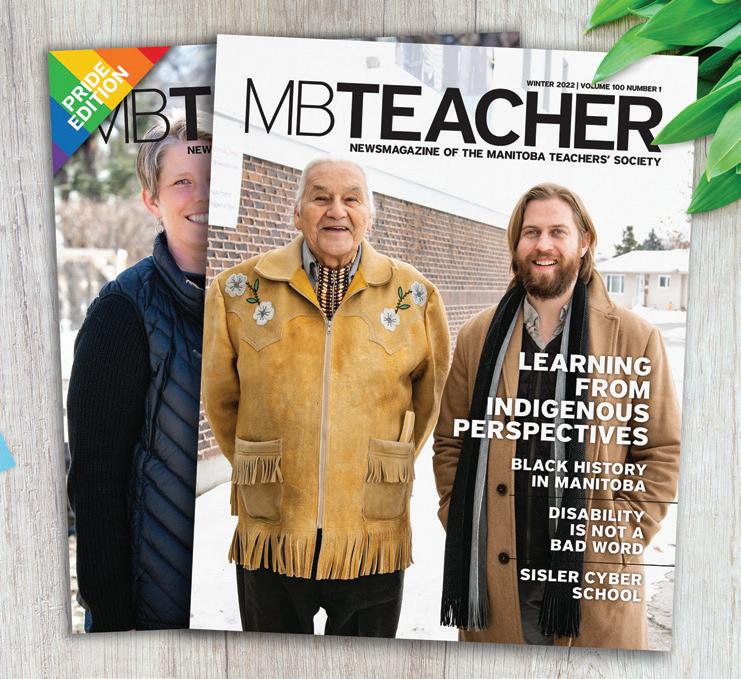

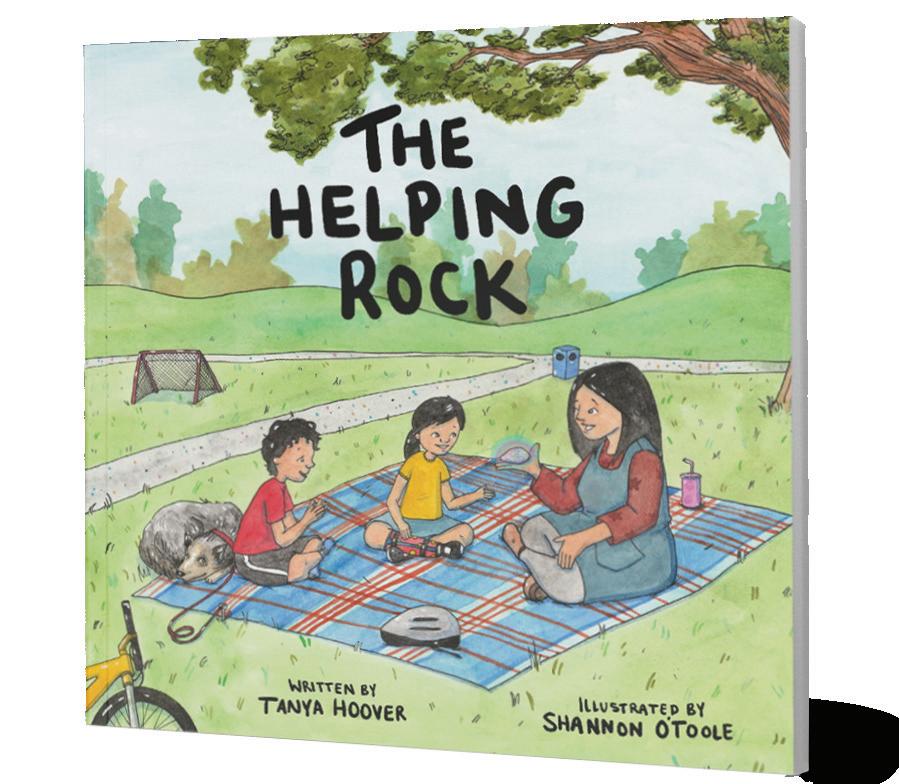
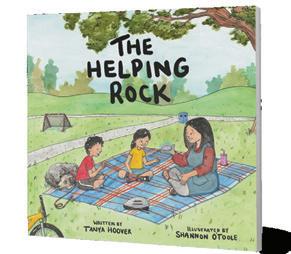

FALL 2022 | THE MB TEACHER 25 Members who wish to receive a printed copy of the magazine must opt to do so in MyProfile. Once you’re in, click the menu item “Make Changes” and in the drop-down menu select “Update My Info”. Under line item “Request MB Teacher” click “Yes – Print” and we’ll continue to deliver your copy directly to your school. MB TEACHER GOES ELECTRONIC MEMBERS MUST OPT INTO PRINT NOV 23 Social-Emotional Learning A Whole-School Approach NOV 29 Attention Deficit Hyperactivity Disorder Strategies for Supporting DEC 7-8 Autism Strategies for Self-Regulation, Learning, and Challenging Behaviours LIVE VIRTUAL WORKSHOPS Purchase now at achieve-publishing.com A Story to Celebrate the Ways We Help Each Other GET 10 % OFF with the coupon code MBTA10 Find more workshops and info at ctrinstitute.com info@ctrinstitute.com 877.353.3205
TIME TO TALK MTS PD
SAGEs INTEGRAL ASSET TO CAREER GROWTH
By Lia Gervino, MTS Staff
The Special Area Groups of Educators (SAGEs) link you to a network of teachers who are passionate about high quality, autonomous professional development in a vast array of specialties.
Teaching is a demanding career; it’s ever-changing and full of diverse experiences—and it’s rewarding too!
Most teachers are aware of the annual October MTS PD Day, but SAGEs offer much more. They provide access to:
• current information and resources related to curriculum and subject areas
• Manitoba Education and Early Childhood Learning advisory committees
• the development of resolutions for the MTS Annual General Meeting of the Provincial Council
• year-long PD offerings
• opportunities to strengthen your leadership skills, and
• a network of teachers new to the profession, new to a curriculum or subject area or those who interested in incorporating new strategies, resources or concepts into what they are already teaching
MTS President James Bedford noted “The professional learning experiences that organizers of SAGEs help provide to our members, and to educators across the province, are integral in helping teachers—regardless of where they are in their careers—to grow and develop as professionals.”
An investment in one’s professional development through a SAGE gives your teaching practice an informed edge. Involvement in a SAGE places you in a position to exercise your voice as a Manitoba teacher invested in highquality educational programming.

GET INTO PD THAT WORKS FOR YOU!
The Manitoba Teachers’ Society prides itself on offering a variety of workshops and events that meet the needs of Manitoba teachers. Workshops for 2022-23 focus on building capacity and awareness in three main areas: equity and anti-racism, mental health and self–compassion, and leadership. These workshops are offered at McMaster House in Winnipeg throughout the year. Can’t get there? We’ve got you covered!
If you’re unable to travel to McMaster House or want to arrange a workshop at your school, The Teacher-Led Learning Team (TLLT) is here to help. The TLLT is made up of teachers who are trained
to provide half or full-day workshops on topics such as Indigenous Education, building safe spaces, how to have difficult conversations and how to build and maintain collaborative relationships. MTS actively recruits members to become part of the TLLT facilitation team—an exciting opportunity to build your leadership, presentation, and public speaking skills.
For those seeking the Provincial Certificate in School Leadership, there’s an option to participate in the threecredit hour field-led course offered by MTS in partnership with COSL, MASS and MSBA. Students must be enrolled in the Post-Baccalaureate program in Educational Administration at the University of Manitoba or Université
26 THE MB TEACHER | FALL 2022
de Saint Boniface, or in the Master of Education program at Brandon University.
The Women in Educational Leadership series offers a range of events and sessions developed to bring together teachers who identify as women in formal or informal leadership positions. The four-part virtual Femlightenment series is held on Saturdays from 10:00 – 11:00 a.m. and begins in October. Each session is hosted by MTS staff and invites women from various sectors of education to talk about their experiences. Author
and former teacher, Marjorie DeLuca is back to host a six-part writers’ series entitled Leaders Write. Marjorie believes that in writing, not only can we stimulate creative thought, but we can use the writing process to bring clarity and synthesize meaning in our lives. This writing series begins in September and will be run simultaneously at McMaster House and virtually. Finally, the annual Women’s Symposium will be held on March 3 and 4, 2023 at the Victoria Inn and Convention Centre.
If you’re looking for something for
your school that you don’t see in the catalogue, contact Professional and French Language Services staff at MTS. We’d love to hear from you.


Information about all the Professional Development sessions, workshops and events can be found on the MTS website under the PD+ tab at mbteach.org
Click here or scan the QR code to find out more about SAGEs or email Lia Gervino, MTS staff officer, at lgervino@mbteach.org
SPOTLIGHT ON SAGEs
The Manitoba Association of Multi-age Educators SAGE is committed to providing professional development opportunities for teachers in multi-age settings. This means, classrooms with multiple grade levels or even a single grade…we are all teachers of multi-age classes! Entering our 15th year, we have seen so much growth as an association. We started with a membership of 40 and now have over 1000 teachers eager to grow, learn and share as professionals in the world of multi-age teaching. In addition to MTS PD Day, membership in MAME includes PD funding for outside events, a professional learning library, quarterly newsletters and a blog, and more!
To learn more, click here , or scan the QR code. Contact Kathy Klenk at chair@ multiagemanitoba.org .
The Manitoba Teachers for Students with Learning Disabilities SAGE is committed to celebrating and raising awareness for those with dyslexia, dyscalculia, and dysgraphia. We are committed to providing teachers with practical tools as well as connecting teachers in Manitoba and across Canada. To that end, we have local and national researchers, parents, teachers, and leaders in English, French, K-12 and adult education sharing strategies for everyday practice and to broaden general knowledge. We’re also showcasing the Manitoba Human Rights Commission‘s update on the Right to Read, which began with the Ontario Human Rights Commission Right to Read Report. We hope you can join us!
To learn more, click here, or scan the QR code. Contact Valdine Bjornson at mtsld2021@gmail.com.
FALL 2022 | THE MB TEACHER 27
THE MANITOBA ASSOCIATION OF MULTI-AGE EDUCATORS THE MANITOBA TEACHERS FOR STUDENTS WITH LEARNING DISABILITIES Introducing Spotlight on SAGEs, a regular feature designed to highlight opportunities for enrichment and inspiration offered by the MTS Special Area Groups of Educators.
HOUSTON, WE HAVE MANITOBANS! LOCALS PARTICIPATE IN ANNUAL NASA CONFERENCE
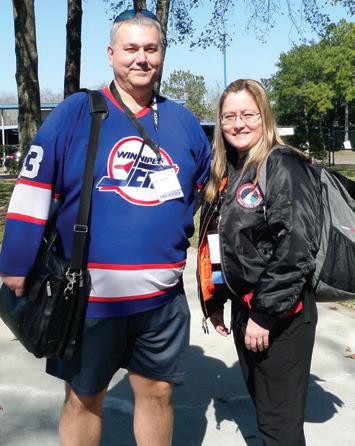 By Ryan Desjarlais, Stevenson Britannia Adult Learning Centre
By Ryan Desjarlais, Stevenson Britannia Adult Learning Centre
Canada has made significant contributions to space exploration, from the famous CanadArm to our many successful astronauts, like Roberta Bondar and Chris Hadfield.
Inspiration to become an astronaut, cosmologist, or aerospace engineer comes from many different sources. Some have spoken about staring into the wonders of the night sky, and others speak of how science fiction gave them the spark. Those, and many more, also talk about how their dreams were further inspired by a teacher!
To help teachers ignite the first stages of interest in their students, NASA hosts an annual event every February for early, middle, and senior years teachers called the Space Exploration Educators Conference (SEEC). It takes place in Houston, Texas, right beside the famous Johnson Space Center (JSC). Teachers from all over the world and from all subject areas converge on Space Center Houston for four days of amazing programming. In 2020, the conference hosted over 700 participants live on the grounds. In 2021, the conference shifted to virtual due to COVID-19, and a hybrid version took place in 2022.
EXPERIENCE ACTUAL
NASA ASSETS
As we enter a year of easier travel times, teachers can once again look forward to attending the SEEC conference live in person. Attendees see and experience actual NASA assets, including a walk-through space shuttle and the newly restored JSC control room used for the first lunar landing.
One Manitoba teacher very familiar with
SEEC is École Stonewall Centennial School’s outstanding space educator, Maria Nickel. With an impressive list of accolades, including a Prime Minister's Award for National Science Teacher of the Year, she’s appeared on television promoting space science and is active with both Canada Space Agency and NASA educator programming. Nickel is an outreach teacher for Space Center Houston, and provides a number of workshops in the Interlake School Division and throughout Manitoba.
INSPIRING, JAW DROPPING, OUTSTANDING SPACE PD
Nickel has participated at the conference for almost a decade, and has been selected as a SEEC Crew member many times. When asked how to sum up SEEC, Nickel has this to say, “It's the most awe inspiring, jaw dropping, outstanding space sciences professional development geared towards educators of all levels, EVER!”
As a SEEC Crew member, Nickel wears a NASA flight suit and helps conference participants from the USA, Canada, Japan, South America, South Korea, Australia, Mexico and Europe. She emphasizes, “All the sessions present ready to implement classroom ideas, and hands-on fun!”
I first heard about the conference during a Manitoba Aerospace Educator's delegation to the Boeing production facilities in Seattle, Washington. My first SEEC was in 2014,
where I was an overwhelmed participant. Seeing all the actual NASA training facilities was amazing!
I’ve returned to SEEC to present on multiple occasions as an outreach teacher with the Perimeter Institute for Theoretical Physics, located in Waterloo, Ontario. The institute encourages future scientists and astronauts alike to unravel the mysteries of physics that exist throughout our great universe.
The 2023 Space Exploration Educators Conference will be held February 9th to 11th. For more information click here or scan the QR code.
28 THE MB TEACHER | FALL 2022

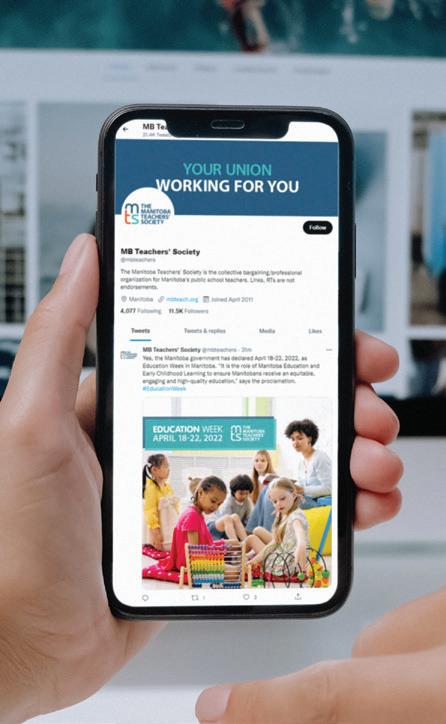
FALL 2022 | THE MB TEACHER 29 OCT. 21 | #MTSPDDAY MTS PD DAY REGISTRATION IS NOW OPEN! Visit mbteach.org for this year’s offerings. FOLLOW US ON SOCIAL MEDIA manitobateachers mbteachers mbteachers Make sure our news follows you by following us on social media. You’ll find fun, inspiration and collaboration with colleagues who’d love to share with you.
TRAINING FOR THE (MENTAL) MARATHON:
CMA WORKSHOPS TAILORED TO TEACHERS
By Irene Nordheim, Canadian Mental Health Association
As the 2022/23 school year picks up steam, we may be breathing a sigh of relief that things are returning to “normal,” removing some of the stresses of the pandemic. Educators, however, are well aware that students will be recovering gradually from the last two years of disruption, and that outside pressures and expectations still exist for our system.
It’s more important than ever to remember to place a priority on teacher mental health. The Canadian Mental Health Association’s website Care for All in Education offers a portal to services and support uniquely tailored to teacher needs.

The Care For All In Education program continues this year with funding from the provincial government, and supported by partnerships with MTS, CUPE, MASS, and school divisions. Through the website, many within the education workforce accessed supports last year, including online workshops and guidance from wellness specialists. And we’re now able to offer inperson workshops on a variety of topics. The opportunity to be together in a room sharing ideas, suggestions and support will never be taken for granted again!
What’s new? Check out the new online direct chat feature that allows individuals to reach out in real time and connect with
a CMA wellness specialist. Also coming soon: Walking with Grief, Boundaries and Compassion in the Workplace
More information can be found on the website here. With new resources being
UPCOMING WORKSHOPS:
Cognitive Behavioural Therapy with Mindfulness (CBTm)
Cognitive Behavioural Therapy with Mindfulness (CBTm)
Introduction to Anxiety: Part 1
Certified Psychological Health and Safety Training
Mental Health Awareness Training for Administrators
Hazard is a Hazard
Looking at Depression
Introduction to Anxiety: Part 2
Walking With Grief
Awakening Compassion in the Workplace
added on a regular basis, be sure to check back frequently! Scan the QR code to register for sessions and find out more.
September 27, 2022 - October 25, 2022
5:30 pm - 7:00 pm
October 12, 2022 - November 9, 2022
5:30 pm - 7:00 pm
October 13, 2022
5:30 pm - 7:00 pm
October 20, 2022 - October 21, 2022
All Day
October 20, 2022
6:00 pm - 8:00 pm
October 21, 2022
All Day
October 24, 2022
5:30 pm - 7:00 pm
October 27, 2022
5:30 pm - 7:00 pm
November 8, 2022
5:00 pm - 7:00 pm
November 17, 2022
5:30 pm - 7:00 pm
30 THE MB TEACHER | FALL 2022


























































Member & Family Assistance Program (MFAP) We can help. Free and confidential support for eligible members and their families. • Relationships and Couples • Family and Parenting • Stress • Anxiety • Depression • Substance Use • Legal and Financial • Grief and Bereavement • Career Coaching • Behavioural Management • Diet and Nutrition • Work-Related Stress • Bullying and Harassment • Crisis and Trauma HumanaCare’s supports and services can assist in the following areas: 1-800-661-8193 24 HOURS A DAY ANYWHERE IN NORTH AMERICA www.humanacare.com/mts Check your MTS email dated December 15 for the access code to set up your personal HumanaCare profile.
THE PRINCIPAL OF THE THING: CARING FOR THE “NEW”
By Alysha J. Farrell Ph. D., Brandon University
As we approach the new school year, I’ve been thinking a lot about what it means for leaders to build relationships with the newest members of their school communities. It can be difficult for folks to put down roots when they feel unknown, vulnerable, or unsure about how to contribute. That said, the “new” warrant special consideration from educational leaders, not only because they require additional support, but because they have the power to loosen old givens.
Fresh observations orient us to the moral and ethical sensibilities of a place.
According to philosopher Simone Weil, “To be rooted is perhaps the most important and least recognized need of the human soul.”
As someone who studies the emotional dimensions of leading, teaching and learning, I’ve learned that educational leaders who nurture a caring ecology in their schools create the conditions for the new to put down roots and to thrive.
A caring ecology is one that provides a relational home for people. It assumes that “newbies” unsettle the school’s culture in generative ways. Focus is placed on fostering connections, and health and wellbeing are understood as a social practice. This runs counter to the individualized notions of care we’ve been sold. I don’t know about you, but I’ve lost count of how many people told me I should take up yoga or download a mindfulness app to deal with bouts of melancholy during the pandemic.
We tend to think of feelings as belonging to individuals when in fact emotions are shared and mutually influencing. In a caring ecology, interdependence is
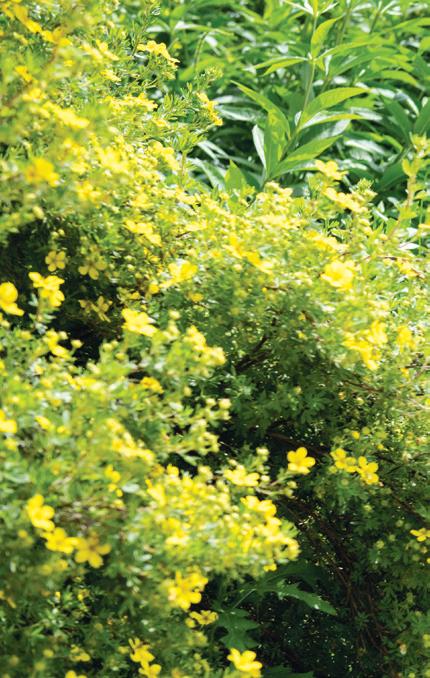
privileged over individualized notions of care and responsibility. Compassion, mutual recognition, and learning to live well with others are the foundational aims. This is educational leadership as soul work.
When leaders focus on tilling the soil of a caring ecology, they create more opportunities for empathy for themselves, their staff, and the children in their care. It’s true these types of connections don’t happen all the time, and when they do, they can be fleeting. Certain people will flummox you, leave you frustrated or even make you feel out of your depth. What I can promise is that it’s well worth your time as an educational leader to try. After all, we learn the most about ourselves in relation to others as we hone our listening and responding skills.
Leaders who cultivate a caring ecology pay particular attention to four things. So let’s explore them in turn.
HOLD SPACE FOR DIFFICULT
FEELINGS
Perhaps most importantly, these leaders hold space for the difficult feelings of others. They are emotionally attuned, meaning
they offer a specific type of attention that’s grounded in hospitality and generosity. Before passing judgement, they operate from a place of curiosity. One of my mentors often asks those who are experiencing intense feelings to simply, “Tell me more about that.” The response demonstrates he’s comfortable bearing witness to suffering without losing himself in the process. It’s easier for a new member of a school community to settle into a conversation with a school leader when they know they can express themselves without being judged. I’ve also found it helpful to remember that in difficult conversations, we all hear echoes of what our significant caregivers judged to be permissible emotional expressions in social situations. I try to remind myself that people are finishing a conversation with someone important from their past as they settle into an emotionally charged conversation with me. Caring ecologies have intergenerational root systems.
REJECT “CAREWASHING”
When I was a term teacher in the first year of my career, I was told repeatedly that if I didn’t coach, volunteer for the drama production,
32 THE MB TEACHER | FALL 2022
or sit on multiple committees, it would be less likely that I would secure a permanent contract. As an untenured new graduate who was buried under a pile of student loans, I listened. My lesson plans suffered and so did my health. When I look back on that time, I interpret the pressure as a kind of carewashing or a type of communication strategy used to obscure the more unhelpful, or even hurtful elements of a request.
Relational educational leaders treat new members of the school community as ends in themselves. It can be tempting to look at a new staff member and see the desperately needed basketball coach but it’s important to resist the urge to cast people into roles. The great theatre artist Augusto Boal once remarked, “...it’s best to see people without the captions!” An educational leader who is focused on growing a caring ecology gives new staff members the time they need to write their own chapter in the school’s unfolding story.
Educational leaders who nurture a caring ecology in their schools value the lived experiences of their staff members. They recognize that prior to joining the school

community, new teachers, students, and caregivers have lived rich and storied lives. Each one of them carries wisdom, gifts and talents that will enrich the social, cultural and knowledge tapestries of the school community. Brené Brown stresses that, “...a leader is someone who holds her or himself accountable for finding potential in people and processes.” A school or classroom should be different in remarkable ways because new people have arrived.
SHARE YOUR TIME
When I ask teacher candidates what concerns them the most about their first teaching job, they often respond with some version of “losing control of the class.” They describe their fears in images of children running wild or in the furrowed brow of a future principal who might perceive their need to ask for help as evidence of incompetence. To mitigate the anxiety new staff members experience, educational leaders can share one of the most precious things they have, their time. Before the first school bell rings, they can bring new staff members together and ask questions like, “How can we support
each other as we settle into the new year?”
These types of invitations are evidence of a fourth thing leaders in a caring ecology do.
FACILITATE CONNECTION
A principal I greatly admire invites new staff members to join her for a spaghetti supper after staff meetings. It’s a time for the new teachers and educational assistants to ask their burning questions. The principal makes the noodles and the sauce, but it's the group that determines what information and supports they need to be successful.
As an educational leader, you play a significant part in the lives of new staff members, children, and families. Their interactions with you not only influence the encounters they have with others on a particular day, but they also shape the interactions they will have with others in the future. The good news is that when compassion passes from person to person, patterns of healthy relationships develop. And if we understand ourselves as stewards of relationships through our leadership work, we will nurture school communities that are rooted in generosity and love.
FALL 2022 | THE MB TEACHER 33
Alysha J. Farrell Ph. D., Associate Professor Brandon University
BOOK REVIEWS
By Sherry Jones, MTS Staff
THE BREAK AND THE STRANGERS
Author: Katherena Vermette Publisher: House of Anansi Press (2016)
The Break and its companion book, The Strangers , are novels by Manitoba author, Katherena Vermette. The Break centers around a violent crime that occurs in an open field in Winnipeg’s North end from the perspective of a woman who witnesses it from her apartment window. The Strangers follows up with some of the same characters and introduces new ones. Intergral to both novels are the intergenerational experiences of a Métis-Anishinaabe family in the wake of the crime.
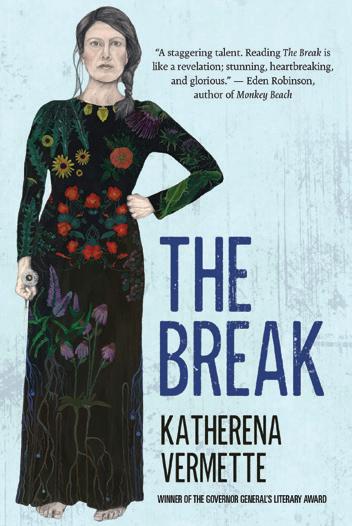
Neither book is an easy read. They present a rare, local, and unvarnished perspective of the pain and grief of intergenerational trauma, systemic
THE BOLD WORLD
Author: Jodie Patterson Publisher: Ballantine Books (2019)
The Bold World, A Memoir of Family and Transformation , by Jodie Patterson, is a memoir about raising a trans child and the prelude of a mother’s honest journey as a Black woman in America. Inspired by her transgender son, Patterson explores many topics including identity, gender, race, family, and authenticity through her own courageous story.

Following a thorough introduction of her own journey into adulthood as a Black woman in America, Patterson confronts her family’s complex existence. In a beautifully written letter that she penned to her family and closest friends, she “breaks the silence…in order
racism and the complexities of crime. Vermette masterfully weaves narratives that depict pain and suffering but also compassion, resilience, wisdom and love.
As educators we recognize the significance of education on our journey towards truth and reconciliation. As settlers on these lands, our commitment to reading and understanding the stories of Indigenous people is an actionable step. Vermette’s stories call us to question our biases, our understanding of the communities we work in and the stories they carry. Both novels should be must-reads for Manitoba educators.
to make space for something good” and shares how she navigated every part of her life in repeat, advocating for her son at home, in school, with family and friends and in the community.
Through her story, we see how her existing definitions of family did not meet her child’s needs. But through her unconditional love, Patterson was able to unlearn and relearn her own attitudes and biases to allow her child to be his true self. We learn that transition doesn’t just belong to the transgender person—in the interest of learning and becoming, it is a gift and a responsibility for all of us.
34 THE MB TEACHER | FALL 2022

Find resources to help teach about residential schools



Explore the Witness Blanket
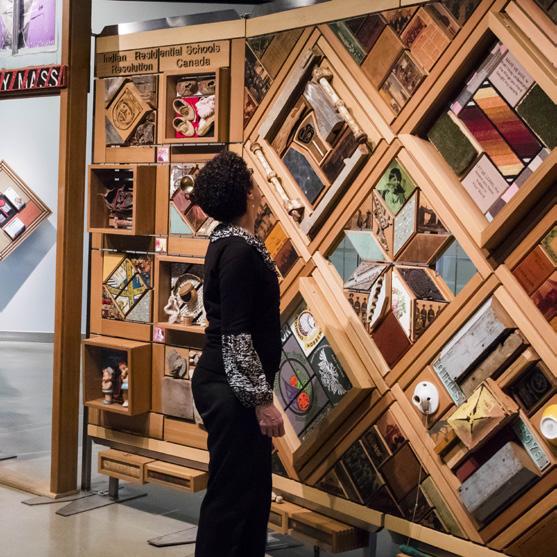

Discover
This
hundreds of reclaimed items accompanied by the stories of Survivors, and move alongside your students, as they learn, empathize, and act together. witnessblanket.ca
website was created in partnership with the Canadian Museum for Human Rights, Carey Newman, Media One, Camosun College and Animikii Indigenous Innovation Supported by













 By Christopher Sarkonak, Brandon Teachers’ Association
By Christopher Sarkonak, Brandon Teachers’ Association























 By Ryan Desjarlais, Stevenson Britannia Adult Learning Centre
By Ryan Desjarlais, Stevenson Britannia Adult Learning Centre






































































